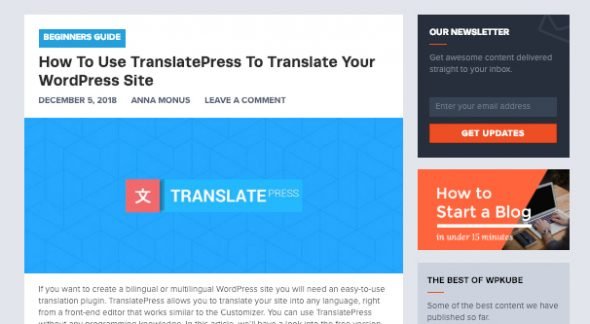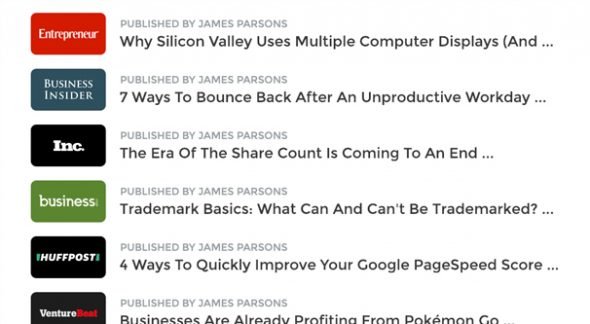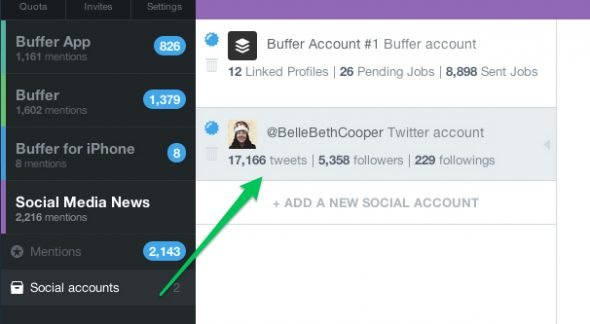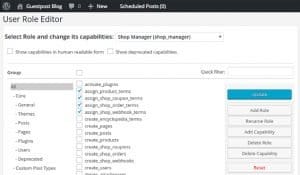You’ve probably gotten to know some familiar faces in your industry. You know the ones. They seem like they’re everywhere. They’re credited as writers on a dozen blogs with big names. They’re linked to constantly. They’re quoted everywhere. And it seems like, every single time someone writes a “20 Experts Weigh In On X” topic, there they are, one of the experts mentioned.
And here you are, toiling away on your blog, providing your service, analyzing your data, and you’re nowhere to be seen. Every writer credit on another site is a long, arduous process of outreach and guest posting, and it’s so hard to repeat you might as well start over every time. Relationships seem hard to come by. No one drops you a line when it comes time to interview experts.
What makes them so much better than you? Are they naturally more talented? Do they just have more connections? Are they somehow inherently, intrinsically better than you?
No, of course not.
No, these other influencers, these thought leaders, they’re no different than you or I. The only thing they’ve done that you haven’t is put in the legwork. They’ve built a framework where people come to them, but that’s nothing new. You can do it, and so can anyone else. In fact, I’ll tell you how.
This first section is all about building up a strong presence. You want to get your own house in order, so you have a solid platform to stand on when you reach out. Your goal is to reach out to a potential interviewer and have them check around, see you well positioned in your industry, and accept. The last thing you want is for them to Google you and find basically nothing except your own website.
1. Build a Solid Content Base
This is a first and a very important step: make sure your home base, the website you use as your flagship (if you have multiple), is full of great content.
Even if you run a dozen other sites, you want this main site to be the one with all the best stuff. The one that out-shines all the others. You aren’t going to be showing off your whole portfolio, just your primary site, so make heavy use of it.
2. Guest Post Anywhere You Can
Guest posting has a lot of benefits – this entire blog is about what they are and how to get them, after all – but the benefit you’re primarily looking for here is a presence. You want your name and face to appear on a variety of different sites, the bigger the better. If you can’t get a guest post spot, become a frequent top commenter. As long as your opinions and your face and name are all in one place on a top URL, it adds authority.
3. Build a Credits Page
Your main site should have an About section, and that section needs to sell you. Tell your story in a few paragraphs, add in professional accolades and credits, and generally sell yourself as an authority in your niche.
Link to places you’ve written, items you’ve had published, and anything else that lends more authority to your name. Don’t turn it into a link wall, though; curate the best, most relevant credits.
4. Build a Testimonials Section
Whether it’s in your profile page or on a different page altogether, you want a section dedicated to personal recommendations. Think the recommendations on LinkedIn, rather than product testimonials. You want people personally recommending you for your insight, your experience, and your skill. You only need a few of these, but if you can get them from big names, you’re ready to rock.
5. Build Up LinkedIn
Most people think of LinkedIn as a job search platform, and to an extent it is. What it also is, however, is a great billboard for you to advertise a huge list of your interviews, experience, and accomplishments without looking like you’re bragging.
Just write up a factual list of your credits, more robust than #3 up above, and put it in your LinkedIn summary.
6. Build Up Confidence
One of the best pieces of advice comes from this article on ProBlogger, and it’s very simple. Have confidence in yourself! That post is primarily aimed at interviewing people much larger than you think would give you the time of day, but you can apply the same confidence to landing those interviews as the interviewee. Pitch yourself with confidence and be the expert you want to be.
This second section is about the “soft” interviews. These are cases where no one is coming directly to you, but you’re still able to participate in groups or in formats where you start the ball rolling.
7. Join HARO
HARO stands for Help A Reporter Out. It’s a site where you can register as either a journalist or an expert. When a journalist needs expert information on a given subject, they can look for experts.
You want to be among the list of experts they can find. Now, it’s not the best source of interviews – there’s little feedback and you often won’t know if your quote is used – but it can be another source of spreading your name around for relatively little effort.
8. Join MyBlogU
MyBlogU is a content creation platform aimed at collaboration. Sound familiar? You won’t quite have the same interviewer-interviewee vibe, though. More often, you’ll end up on a more equal partnership producing a high quality piece of content with expertise from all participants equally. It’s a fairly unique platform, so give it a look.
9. Participate in Twitter Chats
Twitter Chats are essentially moderated group discussions within an industry, revolving around a specific topic, that take place at specific times. It’s more organized than the chaotic soup of normal Twitter interactions. They’re also often good ways to share your expertise and network with other people in your industry, both those looking to ask questions and those looking to answer them. Participate in good chats and you’ll make some friends and be quoted in relevant publications.
10. Join Google Hangouts On Air
You’ve probably seen a few archived Hangouts videos as references here and there, mostly in SEO discussions with John Mueller, one of Google’s public faces.
It will look a little something like this. Participating in one of these can be a good way to get your face in the crowd.
11. Do a Social AMA
Reddit is the king of the Ask Me Anything (AMA) format, where you offer yourself up to be an expert on your subject, allowing anyone to ask you anything they want. AMAs are often cited for months or years to come, and position you as an authority, if you have enough clout to be accepted to do one. You can also do smaller-scale AMA-style open interviews on your other social profiles.
12. Monitor Twitter for Interview Opportunities
Often times, when a writer is looking for an expert round-up, one of those 40-person multi-interview pieces, they’ll take to Twitter to solicit. They’ll send specific customized emails to some key experts, but they’ll take anyone who responds to Twitter as filler if you have a suitable presence.
The thing is, no casual reader knows whether you’re a special expert or a filler, so you get all of the benefits of participating along with the other influencers.
13. Look for People Producing Interviews and Reach Out
Carrying on from the previous step, Twitter is just one way of looking for anyone doing interviews. You can also find any site that has published an interview in your industry and just contact the site owner. “Hey, my name is X, I own Y business and frequently cover A, B, and C topics. I noticed your excellent interviews on B and C, and figured I’d drop my name into the hat if you need someone for future interviews. Cheers!”
For a good pitch, I recommend keeping casual and humble, without bragging too much or begging. Avoid coming across as desperate, but likewise avoid acting like doing this interview is a favor. You just want to share your knowledge because you’re passionate, right?
14. Identify Sites with Interviews as a Primary Feature
Some sites make interviews a primary feature of their content. Woman in Leadership, for example, interviews women in leadership positions. Mixergy often interviews founders of various businesses, particularly the most innovative examples. Entrepreneur on Fire features entrepreneurs with relative frequency. These are all great potential targets for your outreach.
15. Participate in Podcasts
Don’t forget about other forms of content! You don’t need to limit yourself to just blogs. Get a decent microphone and take to the mean streets of podcastia. Podcasts are growing in popularity, and they’re a great way to make a few more ties in the industry.
Finally, this third section is about making the effects of all of the above snowball. Leverage one interview into another, build momentum, and be one of the go-to names in your industry.
16. Add Fresh Credits to Your Bio
Any time you get a new interview, decide what to do with the credit for it. As soon as it’s published, add it to your About Me bio section, to your LinkedIn, or to whatever other profile or catalog of your credits you’re maintaining. Determine if it’s good enough to knock out one of your other best interviews in your main profile, and add it to all of your side profiles. If nothing else, the interviewer will appreciate the links.
17. Refine your Outreach Pitch
As you contact additional interviewers, learn from what does and doesn’t work when you contact them. Refine your pitch! Don’t just use one standard template for everyone. It’s also definitely worthwhile to maintain a list of your outreach, both success and failure.
Don’t try to cold-call someone who already knows you, and don’t try to first-time pitch someone who probably remembers a past pitch.
18. Comment and Engage with Published Interviews
Once interviews are published, make sure you’re engaging with them. Leave a comment adding on anything you didn’t think to mention the first time around – those day-late thoughts – and be sure to thank the author for interviewing you. They’ll appreciate the comment and any additional promotion.
19. Link to Interviews and Promote Them
Speaking of promotion, make sure to give something back to the people who interviewed you. Share the interview on social media, that’s the absolute most baseline thing you can do. For added benefit, link to the interview in a piece of content you’re writing in the near future, to give it some of your share of traffic and link juice.
20. Follow and Engage with Interviewers
Don’t forget the influencers themselves! Once you’ve landed an interview, follow the interviewer on social media. You can even add them to a special Twitter List or something, if you want to keep an eye on the kinds of content they produce – and future calls for more interviews.
The key after all of this is to keep the ball rolling. It will be hard going at first, but the more credits and interviews you get under your belt, the better off you’ll be. This kind of industry and social reputation tends to be a “rich get richer” scenario, where your influence grows the more people who think you have influence. Keep it going.
 ContentPowered.com
ContentPowered.com












